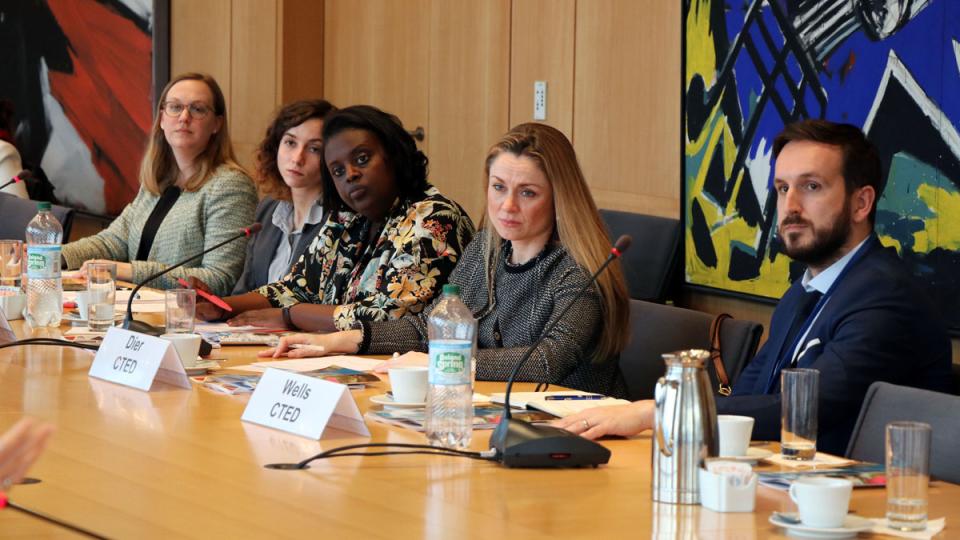Foreign terrorist fighters

On 27 February 2019, at a joint panel discussion with George Washington University, the Counter-Terrorism Committee Executive Directorate (CTED) launched a Trends Report on “The Gender Dimensions of the Response to Returning Foreign Terrorist Fighters”. The discussion was moderated by Ms. Idil Absiye of the United Nations Entity for Gender Equality and the Empowerment of Women (UN-Women), with the participation of Ms. Audrey Alexander of George Washington University, Ms. Devorah Margolin of King’s College London, and CTED experts Ms. Aleksandra Dier and Mr. David Wells. CTED/Vijai Singh
On 24 September 2014, at a meeting held at the level of Heads of State or Government the Security Council unanimously adopted its resolution 2178 (2014) to address the acute and growing threat posed by foreign terrorist fighters (FTFs).
The resolution defines FTFs as “individuals who travel to a State other than their State of residence or nationality for the purpose of the perpetration, planning or preparation of, or participation in, terrorist acts or the providing or receiving of terrorist training, including in connection with armed conflict”, and further notes that FTFS increase the intensity, duration, and complexity of conflicts and may constitute a serious danger to their States of origin, transit, destination, as well as neighbouring zones of armed conflict in which they are active.
At that time, the FTF threat was evolving rapidly and was unlikely to be fully contained in the short term. A significant longer-term risk was posed by FTFs returning to their countries of origin or upon their arrival in third countries.
The Security Council stated that terrorist organizations such as Al-Qaida, the Islamic State in Iraq, and the Levant (ISIL, also known as Da’esh) and associated groups had attracted over 30,000 FTFs to the conflict zones of the Middle East from over 100 Member States. Because the related challenges were by their nature international, the Council called on States to enhance their international cooperation in preventing their travel, noting that attempts to combat the threat through a purely domestic approach would not work.
In both developed and developing countries, significant numbers of young people were considering travelling to areas where their personal security would be at risk. The departure of so many young people to conflict zones had a profoundly destabilizing effect on their communities and, above all, on their families. In order to attract individuals to its cause, ISIL exploited socio-economic grievances and feelings of alienation, marginalization, discrimination, or victimization, precipitated by a host of factors, including real or perceived lack of opportunities, lack of good governance, inequality, injustice, and feelings of injustice.
Women FTFs are often viewed from the perspective of deep-rooted gender stereotypes. The conventional view is that women are less likely than men to engage in terrorism. However, the experiences of many Member States suggest a different picture. In Nigeria, for example, the frequency and intensity of suicide attacks involving women and girls increased sharply in 2015, and Al-Shabaab -publicly called upon parents to send their unmarried daughters to fight alongside male militants. Women have long played significant roles in terrorist movements. The current scale of their involvement in perpetrating acts of terrorism and violent extremism, however, demands a considerably more serious and urgent examination.
The massive reverse flow of refugees and asylum seekers from conflict zones also raised the risk that FTFs would attempt to use the refugee system to escape prosecution.
It should be recalled that all States should establish, in consultation with the Office of the United Nations High Commissioner for Refugees (UNHCR), an effective procedure to grant refugee status to eligible asylum seekers and exclude persons who are not considered to be deserving of international protection in accordance with the 1951 Convention relating to the Status of Refugees.
Terrorist organizations also benefit financially from the FTF phenomenon, whether in the form of donations made by the fighters themselves or in the form of ransoms paid by others to free FTFs from conflict zones.
Security Council resolutions 2178 (2014) and 2396 (2017) establish requirements for States to develop comprehensive and tailored prosecution, rehabilitation and reintegration (PRR) strategies to address this challenge. This requirement is further developed in the Security Council Guiding Principles on Foreign Terrorist Fighters (the 2015 Madrid Guiding Principles and its 2018 Addendum (S/2015/939 and S/2018/117)) and the Technical Guide to the Implementation of resolution 1373 (2001) and other relevant resolutions (S/2019/998).
In the 2021 Global survey of the implementation of Security Council resolution 1373 (2001) and other relevant resolutions by Member States, the Counter-Terrorism Committee notes that many States that are affected by terrorism (including the FTF phenomenon) have yet to develop and/or implement comprehensive PRR strategies. In some cases, the relevant measures are implemented on an ad hoc basis, which may result in the allocation of insufficient structural, financial, and human resources. The adoption of ad hoc measures in the absence of an overall strategy creates the risk that States will adopt and implement ineffective measures at the domestic level. In this regard, CTED’s analysis has identified a widespread need to strengthen coordination between criminal justice actors and other relevant stakeholders.
Key official United Nations Security Council documents on FTFs and other aspects of the CTC/CTED mandate can be found here.
Download the CTED factsheet about foreign terrorist fighters.

